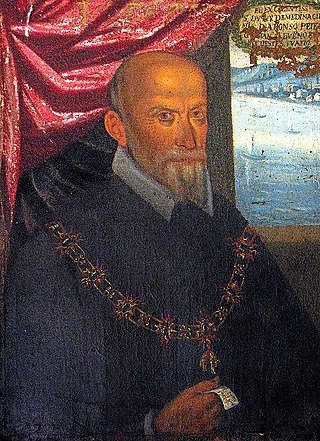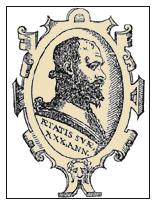Related Research Articles

Alonso Pérez de Guzmán y de Zúñiga-Sotomayor, 7th Duke of Medina Sidonia, GE, was a Spanish aristocrat who was most noted for his role as commander of the Spanish Armada that was to attack the south of England in 1588. He was a great-great grandson of Ferdinand II of Aragon.

Sanlúcar de Barrameda, or simply Sanlúcar, is a city in the northwest of Cádiz province, part of the autonomous community of Andalucía in southern Spain. Sanlúcar is located on the left bank at the mouth of the Guadalquivir River opposite the Doñana National Park, 52 km from the provincial capital Cádiz and 119 km from Sevilla capital of the autonomous region Andalucía. Its population is 68,656 inhabitants.
Juan Pérez de Gijón was a Spanish composer of the Renaissance.

Juan del Encina was a composer, poet, priest, and playwright, often credited as the joint-father of Spanish drama, alongside Gil Vicente. His birth name was Juan de Fermoselle. He spelled his name Enzina, but this is not a significant difference; it is two spellings of the same sound, in a time when "correct spelling" as we know it barely existed.

Luisa Isabel Álvarez de Toledo y Maura, 21st Duchess of Medina Sidonia, GE was the holder of the Dukedom of Medina Sidonia in Spain. She was nicknamed La Duquesa Roja or The Red Duchess due to her lifelong left-wing, anti-Francoist, pro-democracy political activism.

The House of Medina Sidonia is a Spanish noble house originating from the crown of Castile, whose name comes from the Duke of Medina Sidonia, a hereditary noble title that John II of Castile granted to Juan Alonso Perez de Guzman, 3rd Count of Niebla, on February 17, 1445, as a reward for his services to the crown. The Dukedom of Medina Sidonia is the oldest hereditary dukedom in the kingdom of Spain.
Luis de Narváez was a Spanish composer and vihuelist. Highly regarded during his lifetime, Narváez is known today for Los seys libros del Delphín, a collection of polyphonic music for the vihuela which includes the earliest known variation sets. He is also notable for being the earliest composer for vihuela to adapt the contemporary Italian style of lute music.

The Cancionero de Palacio, or Cancionero Musical de Palacio (CMP), also known as Cancionero de Barbieri, is a Spanish manuscript of Renaissance music. The works in it were compiled during a time span of around 40 years, from the mid-1470s until the beginning of the 16th century, approximately coinciding with the reign of the Catholic Monarchs.
Pedro Guerrero was a Spanish composer of the Renaissance.
Juan Alonso de Guzmán y Suárez de Figueroa Orozco, 1st Duke of Medina Sidonia and 3rd Count de Niebla was a Spanish nobleman and military figure of the Reconquista.
The ensalada is a genre of polyphonic secular music mixing languages and dialects and nonsensical quodlibets.
The tono humano was one of the main genres of 17th Century Spanish and Portuguese music.
Juan de Triana was a Spanish composer of the Renaissance period, active in the second half of the 15th century during the reign of the Catholic Monarchs. Pope Sixtus IV issued a bull on 9 February 1478 that listed De Triana as Prebendary of the Cathedral of Sevilla for at least a year before. He later moved to the Cathedral of Toledo, where it was recorded that in 1483 he was a teacher of six children in the Cathedral, with a salary of 18,000 maravedíes, a significant quantity at the time. Possibly Triana held this position until 1490, when he was replaced by Pedro de Lagarto. He died in Seville on 28 January 1494, and was buried near the gate of the chapel of the Virgen de la Antigua. In his will, he left a bequest to endow a chaplaincy to sing twenty-five masses a month for his soul at the altar of San Juan Bautista, near his place of burial.

The Señorío de Sanlúcar or Lordship of Sanlúcar was an independent Christian lordship in the Kingdom of Castile located in and around the modern day city of Sanlúcar de Barrameda. It was taken from the Kingdom of Granada in 1295.
Pedro de Lagarto was a Spanish singer and composer of the Renaissance period.
The Cancionero de la Sablonara is a Spanish manuscript containing polyphonic canciones from Spain and Portugal, composed in the first quarter of the 17th century.
The Cancionero de Turin or Cancionero Musical de Turin is a musical manuscript that contains Spanish secular polyphonic works from the period between the end of the 16th century and the beginning of the 17th century, in the transition period between the Renaissance and the Baroque eras.
The Cancionero de Segovia or Cancionero Musical de Segovia (CMS), also known as Cancionero of the Segovia Cathedral, is a manuscript containing Renaissance music from the end of the 15th century and beginning of the 16th century. It contains a wide repertoire of works by mainly Spanish, French and Franco-Flemish composers. It is kept at the Segovia Cathedral Archives.

Don Jerónimo Sánchez de Carranza,, Jerónimo de Carranza, Portuguese: Hieronimo de Carança; c. 1539 – c. 1600 or 1608) was a Spanish nobleman, humanist, scientist, one of the most famous fencers, and the creator of the Spanish school of fencing, destreza. He was the author of the treatise on fencing De la Filosofía de las Armas y de su Destreza y la Aggression y Defensa Cristiana from 1569, published in 1582. Carranza created the ideal of a poet and a warrior, which became the main guide to life for noblemen.

The House of Guzmán is an old and noble Spanish family that emerged in Castile in the 12th century and became one of the most prominent dynasties of the Spanish kingdom until the 18th century. The original family gave rise to several branches, one of which became Dukes of Medina Sidonia from the 15th century to the 18th century, in turn giving rise to other branches including the Count-Dukes of Olivares.
References
- 1 2 DIAMM - Source: E-Sc Ms. 7-1-28
- ↑ Gómez Fernández, Lucía (2017). Música, nobleza y mecenazgo : los duques de Medina Sidonia en Sevilla y Sanlúcar de Barrameda (1445-1615). ISBN 9788498286571. OCLC 1031102131.